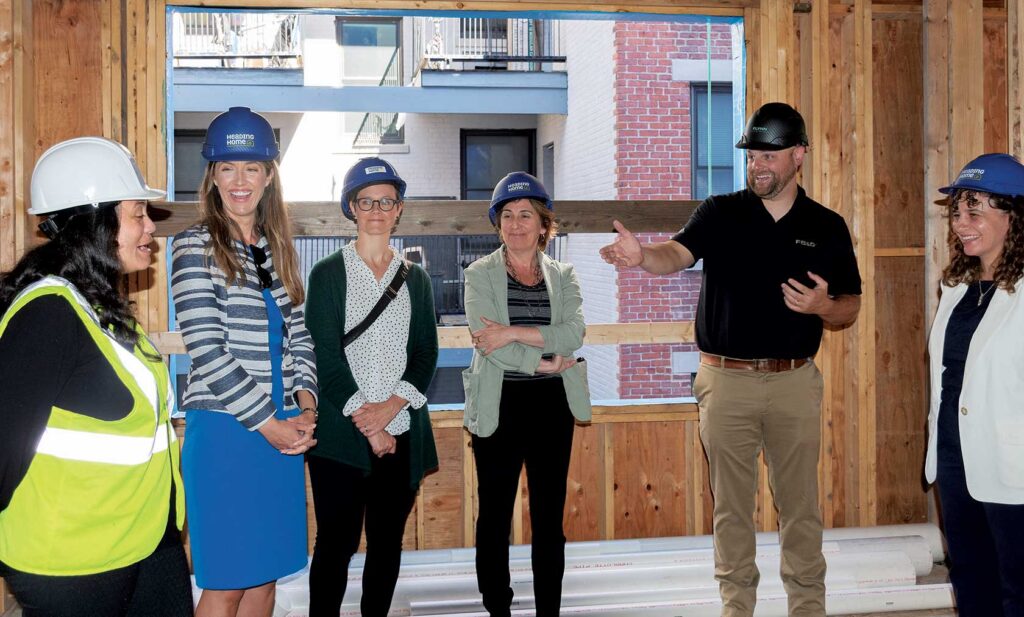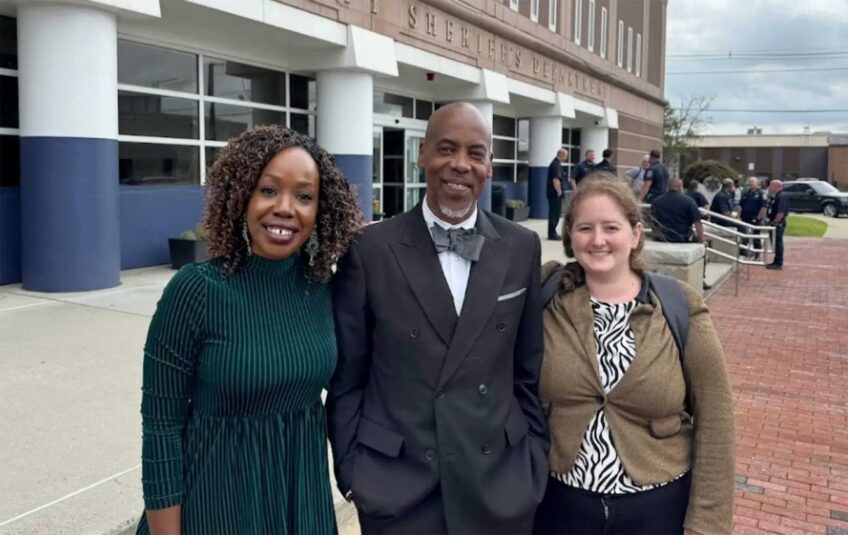City, state move toward green affordable housing
Dorchester development will be free of fossil fuels

For 20 currently unhoused families, a new development in Dorchester will offer permanent supportive housing. It also represents another step to make affordable housing across the state more environmentally friendly.
The development, which is located at 37 Wales St. and will be managed by Heading Home Inc., has been designed to be energy-efficient and fossil-fuel-free. It marks the first time an affordable housing development has made use of GAP III funding — state funding designed to help projects reach funding goals around clean energy development or energy efficiency.
At an event celebrating the development Sept. 20, Energy and Environmental Affairs Secretary Rebecca Tepper said the project is an excellent example of what the state can do to help its lowest-income residents.
“We want to support healthy, energy-efficient housing that provides deep emission reductions,” Tepper said. “This starts with taking concrete steps to aggressively transition our housing stock away from fossil fuel to a reliable and affordable clean energy future.”

Massachusetts Secretary of Energy and Environmental Affairs Rebecca Tepper speaks
at a celebration of a green affordable housing development in Dorchester. BANNER PHOTO
Experts say work around making affordable housing environmentally friendly — often called “greening affordable housing” — tends to fall into three buckets. The first is making the buildings more energy-efficient, with better insulation and less energy consumed for heating and cooling. The second involves electrifying the building and eliminating the use of fossil fuels for cooking as well as heating and cooling. The third bucket focuses on installing renewable energy sources.
Much of the support coming from the city and state is currently focused on retrofitting existing buildings, which presents a greater challenge than building new green affordable housing. State and local officials say that additional challenge makes existing structures the place to start.
The state’s Low- and Moderate-Income Housing Decarbonization Grant Program — the first major initiative the Healey Administration ran through the Department of Energy Resources (DOER) — offers $50 million in grants to help increase energy-efficiency and electrification in affordable housing. The focus was placed on existing buildings because retrofitting them is more difficult, Energy Resources Commissioner Elizabeth Mahoney said.
“We didn’t have the knowledge and we didn’t we didn’t think things through 100 years ago when we were constructing a lot of these buildings, so there are challenges,” Mahoney said. “That’s why we are utilizing these opportunities like this grant program or through the work that we do in our three-year plans to understand what works and what are the most cost-effective solutions?”
In Boston, through the Healthy and Green Retrofit Pilot Program, announced Sept. 21, the city is offering $50,000 per unit to owner-occupants of two- to four-unit homes to decarbonize and electrify.
“In public housing and privately owned and managed affordable housing, the challenges are great, but they have professionals on staff — however stretched they are — where this is their job, and they know how to do this and to manage these big projects,” said Oliver Sellers-Garcia, the city’s Green New Deal director. “But someone who owns a two-family or a triple-decker is most likely not someone who has undertaken this type of project, and we have thousands of projects like this.”
The city is targeting these small multifamily buildings because they pose additional challenges.
“From an implementation standpoint, solving the toughest problems with the most resources certainly raises all boats, because it creates markets and examples for how to do this,” Sellers-Garcia said.
The small affordable housing pilot program follows a separate funding program launched by the city in March to tackle retrofit projects in large affordable housing developments. Additionally, in her State of the City address in January, Mayor Michelle Wu announced a city goal to make all public housing in the city free of fossil fuels.
The prediction that this work is possible is playing out, as more and more buildings are successfully built across Massachusetts with energy efficiency and electrification in mind.
Mahoney said that as of the end of June, there were seven new Passive House buildings — a building certification with metrics on the reduction of energy use for heating and cooling — built in the state, representing about 1,140 new units. There are almost 200 more buildings with this certification moving through the pipeline.
“The worry of the last couple of years — that ‘We couldn’t do this,’ or ‘How could we do this?’ and ‘Is it too costly?’ — those worries are dissipating because of the really concerted effort that the whole system is putting in,” Mahoney said.
When it comes to the third bucket, implementing renewable energy, much of the work on adding solar panels is a developing process.
Isaac Baker, co-CEO and co-founder of Resonant Energy, said when his company began its Solar Technical Assistance Retrofit (STAR) program in 2020, many new affordable housing developments had “solar-ready” roofs — with a slightly more reinforced roof to hold the panels and a dedicated way to run cables from panels from the roof to the basement — but no actual panels, often due to the expense and other complications.
The approval process alone is marred by the sheer number of lenders involved in an affordable housing development, all of whom have to sign off on the addition of the panels.
In a commercial real estate development, there is often only one or two lenders who provided the original financing and would need to sign off, but in affordable housing the number of organizations involved can reach four to nine partners.
When Resonant Energy started its initiative, the approval process could take up to nine months to get all the different organizations — each with its own checklist and list of criteria — to sign off on the addition of solar panels. Since then, Baker’s company has worked on streamlining the process, both for itself and for others who might do similar work, to get the wait time down to two or three months.
Making affordable housing more efficient also bring benefits to the communities and individuals that often are most impacted by environmental problems.
At the 37 Wales St. development, state officials and representatives from Heading Home, Inc. celebrated the clean-air benefits the fossil-free building will have for residents.
“This housing development offers stable housing that not only is good for the environment, but also reduces the burdens of extreme heat and weather events to its residents through energy-efficient heating and cooling,” Tepper said at the event.
That aim holds true across the city’s goals, Sellers-Garcia said.
“Our whole Green New Deal approach is not to chase the easiest way to get rid of emissions, but sometimes it’s actually to go after the hardest ones, because they’re the ones that put people who have carried the burden for longer at the front of the line,” Sellers-Garcia said.






